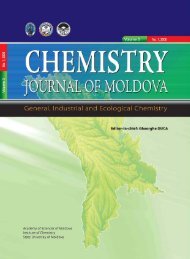stiinte med 3 2011.indd - Academia de ÅtiinÅ£e a Moldovei
stiinte med 3 2011.indd - Academia de ÅtiinÅ£e a Moldovei
stiinte med 3 2011.indd - Academia de ÅtiinÅ£e a Moldovei
Create successful ePaper yourself
Turn your PDF publications into a flip-book with our unique Google optimized e-Paper software.
260<br />
cemiei bazale şi ale HbA1c, comparativ cu LADA 2.<br />
Rezultate similare au fost <strong>de</strong>scrise şi în studiul Ungar<br />
condus <strong>de</strong> Hosszufalusi N. (2003) [6].<br />
Concluzii. În baza celor expuse anterior, se poate<br />
concluziona că diabetul autoimun la maturi se poate<br />
manifesta ca diabet <strong>de</strong> tip I, cu o evoluţie clasică, şi<br />
prin forma LADA, care are un <strong>de</strong>but mai lent. Diagnosticul<br />
<strong>de</strong> diabet autoimun este necesar <strong>de</strong> stabilit<br />
nu doar numai prin prezenţa semnelor clinice şi<br />
paraclinice specifice diabetului <strong>de</strong> tip 1, dar şi prin<br />
confirmări imunologice <strong>de</strong> apreciere a autoanticorpilor<br />
printre pacienţii cu diabet zaharat <strong>de</strong> tip II aparent<br />
cu <strong>de</strong>but la maturi tineri.<br />
Bibliografie selectivă<br />
1. Carlsson A. et al. Insulin and glucagon secretion<br />
in patients with LADA diabetes. In: J. Clin. Endocrinol.<br />
Metabol., 2000, vol 85, p. 76 -80.<br />
2. David R. et al. Type 1 diabetes and latent autoimmune<br />
diabetes in adults one end of the rainbow. In: J. Clin.<br />
End. Met. 2005, vol. 91, no. 5, p. 1654-1659.<br />
3. Davis T., Zimmet P., Davis W., Bruce D. et al.<br />
Autoantibodies to glutamic acid <strong>de</strong>carboxylase in diabetic<br />
patients from a multi-etnic Australian community: the<br />
Fremantle Diabetes Study. In: Diabetes Med., 2000, vol.<br />
17, p. 667–674.<br />
4. Defi nition, diagnosis and classifi cation of diabetes<br />
mellitus and its complications. Report of a WHO Consultation,<br />
1999.<br />
5. Gottsater A. et al. Islet cell antibodies are associated<br />
with β-cell failure also in obese adult onset diabetic<br />
patients. In: Acta Diabetologica, 1994, 31, p. 226 – 231.<br />
6. Hosszufalusi N., Vatay A., et al. Similar genetic<br />
features and different islet cell autoantibody pattern of<br />
LADA compared with adult-onset type 1 diabetes with rapid<br />
progression. In: Diabetes Care, 2003, vol. 26, N 2, p.<br />
452- 457.<br />
7. Ionescu-Tîrgovişte C. Diabetologie Mo<strong>de</strong>rnă.<br />
Editura Tehnică, Bucureşti, 2010.<br />
8. Lohmann T., Nietzschmann U., Kiess W. et al.<br />
„Lady-like” is there a latent autoimmune diabetes in the<br />
young? In: Diab. Care, 1999, vol. 23, p. 1707–1708.<br />
9. Leslie R., Pozzilli P., Type 1 diabetes masquerading<br />
as type 2 diabetes. Diab. Care, 1994, vol. 17, p.1214–<br />
1219.<br />
10. Molbak A.G., Christau B. et al. Inci<strong>de</strong>nce of insulino-<strong>de</strong>pen<strong>de</strong>nt<br />
diabetes mellitus in age groups over 30<br />
years in Denmark. Diab. Med. 1994, vol. 11, p 650–655.<br />
11. Pozzilli P., Di Mario U., Autoimmune diabetes<br />
not requiring insulin at diagnosis (latent autoimmune diabetes<br />
of the adult): <strong>de</strong>fi nition, characterization, and potential<br />
prevention. Diabetes Care, 2001, vol. 24, p. 1460–<br />
1467.<br />
12. Turner R., Stratton I. et al. UKPDS 25: autoantibodies<br />
to islet-cell cytoplasm and glutamic acid <strong>de</strong>carboxylase<br />
for prediction of insulin requirrement in type 2<br />
diabetes. Lancet, 350, 1288–1293, 1997.<br />
13. Weslley P., Souza R., et al., Comparison of cli-<br />
Buletinul AŞM<br />
nical and laboratory characteristics between adult-onset<br />
type 1 diabetes and latent autoimmune diabetes in adults.<br />
Diabetes Care vol. 28, p. 1803–1804, 2005.<br />
14. Zimmet P.., Turner R., McCarty D. et al., Crucial<br />
points at diagnosis: type 2 diabetes or slow type 1 diabetes.<br />
Diabetes Care, 1999, vol. 22, p. 59-64.<br />
Rezumat<br />
Diabetul zaharat <strong>de</strong> tip 1 este o patologie autoimună,<br />
care <strong>de</strong>termină <strong>de</strong>strucţia celulelor ß-pancreatice. O parte<br />
din persoanele adulte care au modificări imunologice specifice<br />
diabetului autoimun nu necesită administrarea insulinei.<br />
Debutul la un astfel <strong>de</strong> tip <strong>de</strong> diabet este la o vârstă<br />
adultă, şi <strong>de</strong>oarece iniţial nu necesită insulinoterapie, acesta<br />
este specificat ca un diabet <strong>de</strong> tip 2. În acest caz se stabileşte<br />
diagnosticul <strong>de</strong> LADA (Latent Autoimmune Diabetes<br />
of the Adult). O atenţie <strong>de</strong>osebită se cere acordată acestei<br />
forme <strong>de</strong> diabet, <strong>de</strong>oarece tratamentul a<strong>de</strong>cvat al acesteia<br />
ar putea influenţa viteza progresării insulino<strong>de</strong>pen<strong>de</strong>nţei şi<br />
ar proteja secreţia <strong>de</strong> C-peptid.<br />
Summary<br />
Type 1 diabetes is caused by the immune-<strong>med</strong>iated<br />
<strong>de</strong>struction of pancreatic β-cells. A fraction of individuals<br />
with humoral immunological changes have clinical diabetes<br />
that initially is not insulin-requiring. The onset of diabetes<br />
is usually in adult life, and because their diabetes is at least<br />
initially not insulin-requiring, they appear clinically to<br />
be affected by type 2. These patients are <strong>de</strong>fined as being<br />
affected by an autoimmune type of diabetes not requiring<br />
insulin at diagnosis, which is also na<strong>med</strong> latent autoimmune<br />
diabetes of the adult. Special attention should be paid to<br />
diagnose such patients because therapy may influence the<br />
speed of progression toward insulin <strong>de</strong>pen<strong>de</strong>ncy, and in<br />
this respect, efforts should be ma<strong>de</strong> to protect C-pepti<strong>de</strong><br />
secretion.<br />
Резюме<br />
Сахарный диабет 1-го типа – это заболевание,<br />
в основе которого лежит аутоиммунная деструкция<br />
β-клеток, приводящая к абсолютному дефициту инсулина.<br />
В популяции больных сахарным диабетом существует<br />
группа пациентов с генетическими и иммунологическими<br />
маркёрами, характерными для сахарного<br />
диабета 1 типа, которая с точки зрения клининческих<br />
проявлений часто не нуждается в назначении инсулина<br />
при первичном выявлении заболевания. Таких пациентов<br />
часто относят к СД 2 типа. Было предложено новое<br />
название для этого подтипа СД – латентный аутоиммунный<br />
диабет взрослых. Принимая во внимание аутоиммунный<br />
патогенез LADA, необходимо отметить, что<br />
раннее назначение инсулина данной группе пациентов<br />
имеет значенение не только в нормализации метаболизма<br />
жиров и углеводов, но и в реализации защитного<br />
эффекта против аутоиммуного поражения β клеток<br />
поджелудочной железы.

















